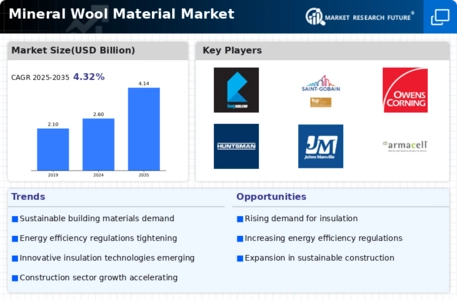Rise in Construction Activities
The Global Mineral Wool Material Market Industry is significantly influenced by the rise in construction activities across various sectors. Urbanization and population growth are driving the demand for new residential and commercial buildings, which in turn increases the need for effective insulation solutions. Mineral wool's properties make it an ideal choice for contractors looking to enhance energy efficiency and soundproofing in their projects. As construction spending continues to rise, the mineral wool market is likely to benefit, with projections indicating a compound annual growth rate of 4.32% from 2025 to 2035.
Regulatory Support and Incentives
Regulatory frameworks and government incentives play a crucial role in shaping the Global Mineral Wool Material Market Industry. Many governments are implementing policies that promote the use of insulation materials that meet specific energy efficiency standards. These regulations often include financial incentives for builders and homeowners who choose mineral wool for their projects. Such support not only encourages the adoption of mineral wool but also enhances its market presence. As these regulations become more widespread, they are expected to drive market growth, contributing to the anticipated increase in market size.
Growing Demand for Energy Efficiency
The Global Mineral Wool Material Market Industry is witnessing a surge in demand driven by the increasing focus on energy efficiency in construction. Mineral wool, known for its excellent thermal insulation properties, is becoming a preferred choice among builders aiming to meet stringent energy codes. In 2024, the market is projected to reach 2.6 USD Billion, reflecting a growing recognition of mineral wool's role in reducing energy consumption. This trend is particularly evident in regions with rigorous energy efficiency regulations, where mineral wool is utilized in both residential and commercial applications to enhance insulation performance.
Technological Advancements in Production
Technological advancements in the production of mineral wool are significantly impacting the Global Mineral Wool Material Market Industry. Innovations in manufacturing processes have led to improved product quality, enhanced performance characteristics, and cost-effectiveness. These advancements allow manufacturers to produce mineral wool with better insulation properties and lower environmental impact. As production techniques evolve, the market is likely to see an increase in the adoption of mineral wool in various applications, further solidifying its position in the construction industry.
Sustainability and Eco-Friendly Building Materials
Sustainability is a pivotal driver in the Global Mineral Wool Material Market Industry, as stakeholders increasingly prioritize eco-friendly building materials. Mineral wool, derived from natural or recycled materials, aligns with the global shift towards sustainable construction practices. This material not only provides thermal and acoustic insulation but also contributes to reducing the carbon footprint of buildings. As governments worldwide implement stricter environmental regulations, the demand for sustainable materials like mineral wool is expected to grow, potentially propelling the market towards a valuation of 4.14 USD Billion by 2035.




















Leave a Comment